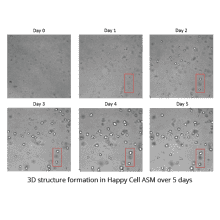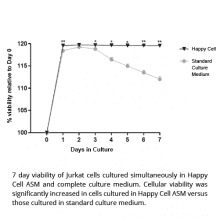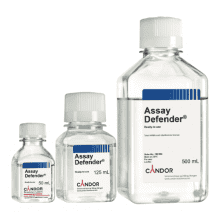1. What is Happy Cell ASM?
Happy Cell ASM is a unique, low viscosity cell culture medium that meets all the requirements that labs in the drug discovery world are currently demanding: Cost effective, scalable, rapidly deployable, simple to use, and compatible with automation with minimal human intervention. This technology features a unique modified natural inert polymer suspension system that can be de-activated allowing for analysis and recovery of cell and tissue samples.
2. How is Happy Cell ASM supplied?
Happy Cell ASM is supplied as a 4X concentrate in a 25ml volume. This is sufficient for 1000 experiments using a 1X concentration in a 96 well plate.
3. How should Happy Cell ASM be stored?
Happy Cell ASM should be stored at 2-8°C and never frozen. Under these conditions, it is stable until the expiration date on the packaging. It can be shipped at ambient temperature.
4. Does Happy Cell ASM contain an antibiotic?
Yes, Happy Cell ASM contains Penicillin-Streptomycin at a final concentration of 1%. If you are interested in the possibility of obtaining Happy Cell without antibiotics, please contact us.
5. Does Happy Cell ASM contain growth factors?
Happy Cell ASM does not contain any growth factors. Additional supplements, such as growth factors and FBS, need to be added by the end user at their desired concentration.
6. What culture vessel should be used to culture cells in Happy Cell ASM?
For optimal Happy Cell ASM performance we recommend using low attachment culture vessels such as 50ml bioreactors and 96 well plates.
7. What is the optimal temperature for dispensing Happy Cell ASM?
Happy Cell ASM can be dispensed at any temperature above 4°C. We recommend warming Happy Cell ASM to room temperature (18 – 22° C) prior to dispensing.
8. How long can cells be cultured in Happy Cell ASM?
Cells can be cultured indefinitely in Happy Cell ASM once they are appropriately maintained.
9. How long before spheroid formation takes place?
The duration of time taken to observe spheroid formation in Happy Cell ASM and for spheroids to reach a certain size varies between cell lines. Typically, 3D structures will begin to form within 24 hours of seeding. We recommended regular sampling and microscopic observation of cultures in order to monitor spheroid growth.
10. How stable is the Inactivation Solution?
If stored correctly (2-8°C) Happy Cell ASM Inactivation Solution is suitable for use until the expiry date on the outer packaging.
11. Can I perform microscopic analysis on spheroids cultured in Happy Cell ASM?
Yes, Happy Cell ASM has been formulated to be compatible with imaging systems. Spheroids in suspension can be viewed with light microscopes. For imaging, we recommend using the Inactivation Solution to sediment spheroids to the vessel imaging surface.
12. Does Happy Cell ASM have auto fluorescence?
Happy Cell ASM does not present an obstacle to most fluorescence-based assays. However, it can be formulated in Phenol Red-free media, if desired.
13. Can I harvest spheroids from Happy Cell ASM?
Spheroids are easily harvested from Happy Cell ASM using the Inactivation Solution. See suggested protocol.
14. Can I isolate protein and nucleic acids from spheroids cultured in Happy Cell ASM?
Yes, once spheroids are treated with the Inactivation Solution, they can be harvested, transferred to a centrifuge tube, pelleted, and treated as you would 2D cultures. Alternatively, you can culture spheroids in 50ml bioreactor tubes and perform inactivation and centrifugation in these vessels.
15. How do I disaggregate spheroids grown in Happy Cell ASM?
Spheroid disassembly or disaggregation can be achieved either by treating the spheroids with Accutase Solution or with Trypsin/EDTA for 20 minutes at 37°C in a humidified atmosphere of 5% CO2. The disaggregation can be enhanced by periodically back pipetting every 10 minutes until cells are fully liberated.
 3D structure formation in Happy Cell ASM over 5 days
3D structure formation in Happy Cell ASM over 5 days




 Happy Cell Inactivation Solution
Happy Cell Inactivation Solution Happy Cell ASM Starter Kit
Happy Cell ASM Starter Kit Happy Cell ASM General Purpose & Scale Up Kit
Happy Cell ASM General Purpose & Scale Up Kit

